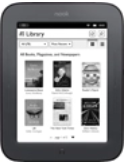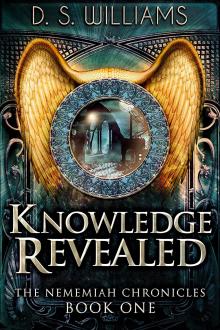Nook eReader Review
Design - Weight and Dimensions
Dimensions: 7.7 in x 4.9 in x 0.5 in
Weight: 12.1 ounces
Color: Available in white
Barnes & Noble shook up the conventional eReader market when they unveiled their new Nook device, as it was the first strongly-backed competitor to Amazon's Kindle devices. Where the Kindle is black, the Nook is white. Where the Kindle has a physical keyboard, the Nook comes without one. Where the Kindle connects to Amazon's library of books, the Nook plugs directly into the Barnes & Noble bookstore. In Nook reviews Readers familiar with eReader devices immediately noticed that the device is white, light, and quite different from its Kindle competitors.
Display - Resolution and Reflectiveness
Display Type: 6 inch monochrome eInk display
Resolution: 800x600
Color Depth: 4-bit monochrome with 16 gray levels
While the Nook eReader does things very differently than its nearest competitor, the Kindle, it does one thing quite the same: it comes with a monochrome eInk display that is capable of display 16 levels of gray. The inclusion of this display is largely due to just how easy it is on the eyes, and how well it displays the pages of a book without requiring squinting or headaches on behalf of those doing the reading. The eInk display can be easily seen in all levels of sunlight or ambient light, and is incredibly easy to read.
User-friendliness and Interface - Touchscreen vs Keyboard
The Nook comes with a touch-enabled display that houses a virtual keyboard, rather than a physical input device like the old Amazon Kindle. This is good, because it allows the keyboard to be contextual and adapt to the task the user is performing at the time. However, the virtual "keys" can be hard to press, and they often fail to respond to a user's touch. That can be frustrating for a lot of people. The device's interface largely comes from the Android operating system, which powers every aspect of the Nook, and it can be both user-friendly and user-challenging at times -- it all depends on the task being performed.
Memory - Internal and External Storage
Flash Memory: 2GB internal memory
Flash Cards: Does not support any removable media expansion
The Barnes & Noble Nook comes with an included 2 gigabytes of flash memory that can be used to store books, music files, or images. The unfortunate aspect of this small amount of memory is that it cannot be expanded. Whereas most similar devices will include smaller amounts of internal memory in favor of adding an SD card down the road, the Nook simply doesn't support expansion at all. That's disappointing.
Formats - Doc, PDF, ePub and Third-party DRMs
Supported Text Formats: EPUB, PDF
Supported Image Formats: JPEG, PNG, GIF, BMP
An eReader like the Nook reader needs to be able to support a wide range of formats so that users can, well, read a lot of documents on it. Unfortunately, the Nook only supports EPUB and PDF files. While those file formats cover a good number of digital publications, they won't help users who are trying to read typical TXT files on the eInk display, or read documents saved in Microsoft's DOC format on the road. Its image support is robust, just like many competing eReaders on the market.
Web-browsing and Applications
The Barnes & Noble Nook supports connectivity via both WiFi b/g protocols and 3G wireless networks. That's important to note, as many eReader devices simply do not support interfacing with 3G networks at all. It means that the device is not dependent on a WiFi connection alone -- or worse, a USB connection to a physical laptop. And because the Nook is powered by Android, it is far more extensible and usable in online capacities than many of its competitors.
Users will appreciate the connectivity options included, especially because it allows them to download books on the go from Barnes & Noble's proprietary bookstore.
Battery-Life
The Nook's battery lasts for about 5,500 page turns -- or about two to three days of reading. That's not bad, but Amazon's Kindle devices have been known to last up to a week. And even the non-Amazon competitors are getting better, with battery ranges that last up to a week.
Pricing
Where the Nook truly wins is on price: the device is available for an easily-affordable $89 with WiFi support. Unfortunately for B&N, Amazons Kindle devices are even more competitive when it comes to price.
Additional Features and Accessories
Perhaps the biggest feature of this particular eReader is that it is powered by the Android mobile operating system. This is the same system found in many current smartphones, and it means the device can be easily updated and given new functionality over time. Those who value open source software and a device which lasts longer than others will appreciate the inclusion of Android.
The Bottom Line
The Nook is a solid competitor to the Amazon Kindle, and might be the first device to really give the industry-leading Kindle a run for its money. There is room for improvement -- especially regarding file format support and battery life -- but this is a great first attempt by Barnes & Noble and its sure to please entry-level eBook consumers with its ease of use and direct connection to America's largest book retailer.





